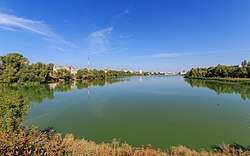Kaban Lakes
The Kaban Lakes (Tatar: Cyrillic Кабан күле, Latin Qaban küle, Arabic قابان كولئ; Russian: Кабан, lit. 'Boar') are a system of lakes in Kazan, Republic of Tatarstan, Russia that includes Nizhny (Blizhny) Kaban, Verkhny Kaban, and Sredny Kaban. With a combined area of 1.86 square kilometers (0.72 sq mi), they comprise the biggest lake in Tatarstan.[1]
| Kaban Lakes | |
|---|---|
 Lower Qaban | |
| Coordinates | 55°46′30″N 49°7′25″E |
| Lake type | Volga riverbed + karst processes |
| Primary outflows | Bolaq |
| Basin countries | Russia |
| Max. length | 5,575 m (18,291 ft) (Nearby+Remote); 1,030 m (3,380 ft) (Upper) |
| Max. width | 350 m (1,150 ft) |
| Surface area | 1.86 km2 (0.72 sq mi) |
| Max. depth | 12.5 m (41 ft) |
| Water volume | 11.8×106 m3 (420×106 cu ft) |
| Surface elevation | 51 m (167 ft) |
| Settlements | Kazan |
The lakes are connected with the Kazanka River by the Bolaq channel and a subterranean channel from Bolaq-Qazansu. They are also connected with the Volga River by the city's sewage system.
The Thousandth Anniversary of Islam Mosque is situated on the bank.
The medieval Volga Bulgarians' graves which date back to 12-13th century were founded on the banks of Arğı Qaban.
One legend claims that, in the days before the Khanate of Kazan fell, the Khans threw all their valuables into the lakes.
Another legend about the origin of the lakes' names claims that, at the Mongol invasion of Volga Bulgaria, the Bulgarian prince Qabanbäk, escaped from Bilär city (or in Bolghar), fled to the banks of the lake and built a castle. Another version is that he founded İske Qazan.
Tatar myth also places Zilant, who had been transformed to Diü, as the ruler of the mythological Underwater Kingdom of Qaban.
 Cityscape at Lower Qaban
Cityscape at Lower Qaban Frozen Qaban from Kazan State University's building
Frozen Qaban from Kazan State University's building- Kamal Theatre and Tatenergo office at the Qaban's embankment
 Fountain on Lower Qaban
Fountain on Lower Qaban
References
- Mingazova, Nafisa; et al. "Restoration of Low Kaban Lake (Kazan, Russia): 25-term experience of restoration and monitoring of ecological condition" (PDF). Kazan State University. Archived from the original (PDF) on 24 November 2015. Retrieved 15 January 2013.
- "Кабан күле". Tatar Encyclopaedia (in Tatar). Kazan: The Republic of Tatarstan Academy of Sciences. Institution of the Tatar Encyclopaedia. 2002.